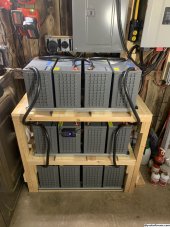The middle battery would get more discharge/charge.
Diagonal corners should be a bit better although not perfect.
If 2 or 4 strings, there are ways to make wire length identical. To do it with 3, I think that would take 3 matched wires.
Right now I have just single strings of AGM, will be doing one with 2 strings (2p8s x 6V for 48V).
One of my inverter setups has 3, but balance there isn't so important.
Recharging sufficiently, and with proper parameters, is the most important.
Are these around 100Ah, so 300 Ah 48V, 15 kWh?
Probably wants around 0.2C, 3kW charge rate.
Is this charged by your 6x 535W panels? Only hits 0.2C under ideal conditions.
Lower charge rate is OK for my batteries according to manual, but the recommend longer absorption.
And of course you need to supply loads as well, and recharge something like 120% of what was drawn from the batteries.
More panels would probably help, especially during shorter winter days. Unless you don't use much.



